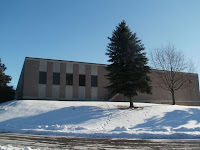It takes a long time to turn raw sewage into clean water that can be channelled into the river without polluting it; ROPEC, the Robert O. Pickard Environmental Centre is the waste water treatment plant in Ottawa that does exactly that. Chris and I had a guided tour of it on the
Doors Open day at the beginning of this month. We found it fascinating.

"Thirty-five rain-barrels of sewage per second are collected here, representing 30 million toilet flushes per day," so we were told at the start of the tour by Michel Chevalier, the Managing Director for water treatment in Ottawa, as we stood in the main building where V16 generators can react to a power outage within seconds. In the underground corridors down which we were led were very long parallel pipes carrying this "raw sludge" along the first stage of its journey through the works or fibre optics cables for the
PLCs (Programmable Logic Controllers) responsible for the machinery. Every part of the system is automated, to the extent that it only requires two human operators to be present in the control room at any one time.
There are 5000 km of sewer pipes buried in the national capital and they all lead to this site. 100 ft below the surface the sewage is filtered through a small screen 4 inches wide where the larger "debris"––i.e. bits of washing machines, golf balls, toys, people's dentures, vegetable knives, stones, toys, bank cards, you name it––are trapped and retrieved, to be put into a smelly dumpster (skip) that fills to capacity every month, its contents to be buried in a landfill. The rest of the sludge is pumped up to ground level, then "gravity fed" through the plant. The start of this occurs in an open channel where the smaller debris and grit is filtered out, bubbles keeping the particles in suspension.
Holding our noses or trying not to breathe too much, we were guided across a bridge over this channel and then through a pungent enclosed area where big vats stored the interesting mix, with "sampling nipples" on their sides.
Large "settling tanks" covered in concrete receive the sludge where oils can rise to the top as scum to be skimmed off––though people ought not to put fats into the sewage, they do––and the organic mush can sink to the bottom. Now these heavier parts can be dealt with.
A process called "anaerobic digestion," lasting from 15 to 25 days, converts some of it into carbon dioxide and methane, the latter of which is retrieved and converted into electricity to power the machinery and heat the buildings. Excess methane is burned off there and then, and it has to stay alight in case of flares. We saw it burning quite impressively, like the Eternal Flame on Parliament Hill. The remaining "bio mass" is centrifuged to separate the liquid from the bio-solids. The solid stuff, being rich in nutrients, can eventually be carted away and used as fertilizer on our fields.
 |
| Clean water at the end of the process |
By means of aereation (i.e. bubbles of air), oxygen burning micro-organisms can now break down the small particles in the water that remains from the original sewage; our guide spoke of a sour dough recipe as an analogy and called these tanks clarifiers.
Towards the end of the clarification treatment, chlorine is added to kill any toxins in the water as its flow slows ever more sluggishly through large circular tanks open to the skies. They contain "rakes" that rotate once per hour. Finally, because we mustn't have chlorinated water going into the river, enough sodium bi-sulphate is added to neutralise it, the final bi-product being salt. Then the fresh water runs over a weir (as shown in the photo above), its flow helping to turning the last machine in the process.
I got that last piece of information in answer to a question I asked about capturing the water's energy but what I should have asked, and only thought of later, is the question about what happens to the chemicals that get into our sewage through medication; there was no mention of this subject. Should we be worrying about it?

















































